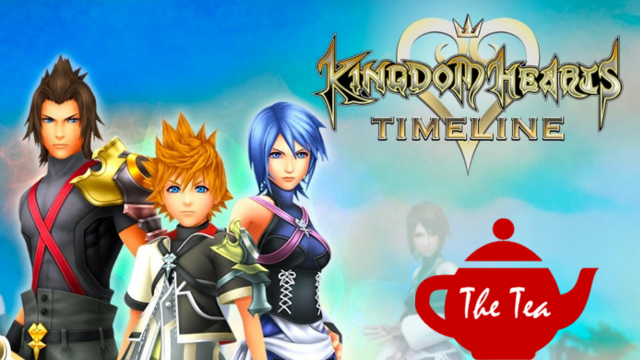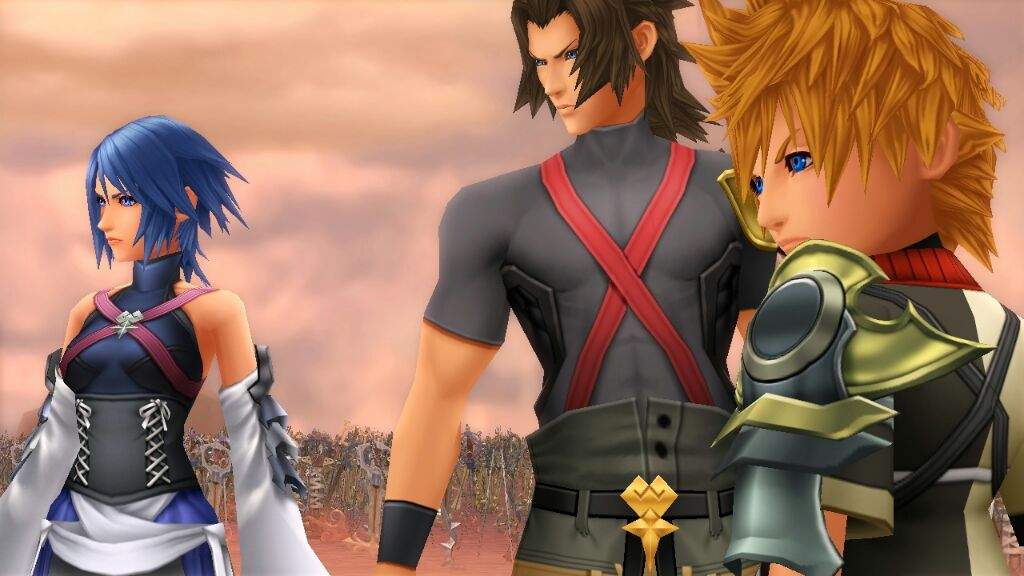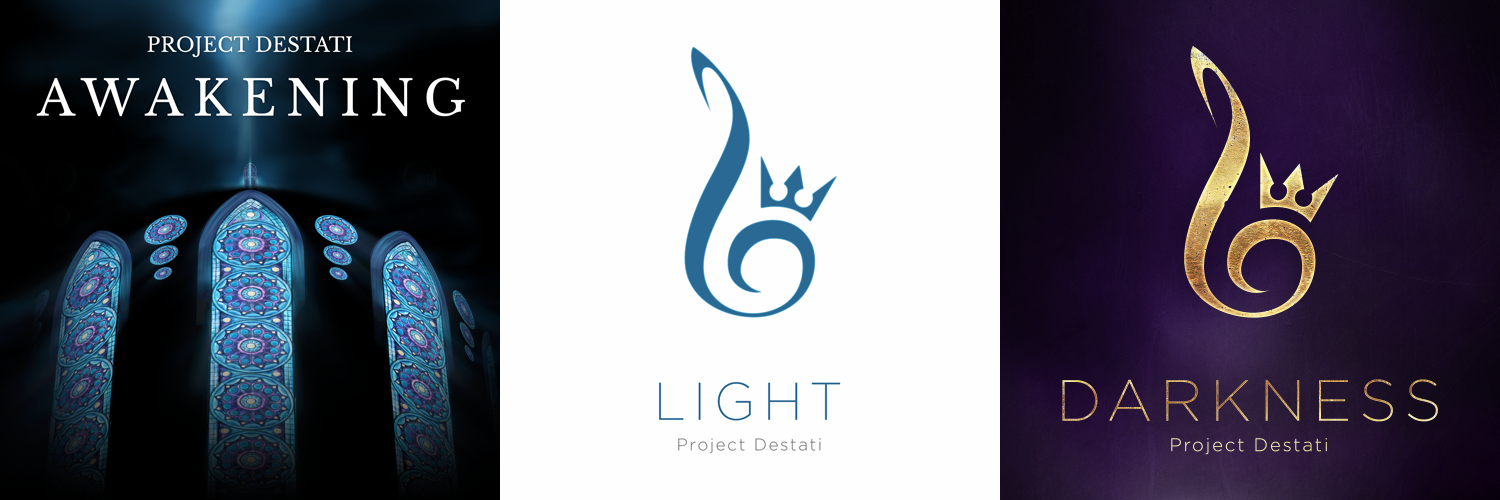Remember when Kingdom Hearts was just “Disney meets Final Fantasy”? Who knew that would be as simple (and clean) as it’d get. Spanning nine titles and nearly as many platforms, KH has built a franchise the way I might build a cake: foregoing the advice of actual bakers to add layer after layer until I have a deliciously unstable cake-tower, loosely held together by candy-sweet frosting and regret.
Call it complexity or convolution, but we’re like seven “side games” from calling KH coherent. It’s a growing pain Square-Enix has been scrambling to alleviate with PS4 remasters of the entire series, all in the hopes that new fans can theoretically get up to speed before the long-long-long-awaited release of Kingdom Hearts III next year.
But let’s be real: who has time to replay all those games? Better question: who actually wants to keep playing Kingdom Hearts Union χ[Cross]? Yes, there are now official recap videos, but this story’s been brewin’ for 15 years. How can a cutscene compilation do it any justice?
Enter Marco, better known as Everglow, who’s made a bit of a name for himself among KH diehards for his playthroughs, Union χ[Cross] story translations, and, of course, the 30-min extended KH tracks that have quickly taken over my music playlists. À la Jiminy Cricket, Everglow’s been a steady KH chronicler since 2012, but this past April, he launched his most ambitious project to date: retelling the entirety of the Kingdom Hearts saga. In video. Chronologically.
At first glance, Everglow’s Kingdom Hearts Timeline (KHT) might sound deceptively simple, but don’t be fooled into thinking this is just another playthrough. KHT lines the very scattered pieces up in the exact order they occur. So like, Aqua is chugging through the Realm of Darkness while Sora is making his first (of so, so many) trips through Agrabah. Untangling 15 years of interwoven plot threads would be a huge undertaking on its own, but KHT takes it several Sora-shoe-sized steps further by setting out to retell the KH saga as effectively (and affectingly) as possible.
Top and above: Most episodes pull from several titles to realign the story chronologically.
We’ve seen cutscene compilations before, of course, but even Nomura-certified ones, like the Days and Coded “movies”, fall flat because video games, by virtue of their medium, tell the bulk of their stories through first-hand experience. With this in mind, Everglow creates each episode with a balanced mix of cutscenes and gameplay, carefully curating a unique rhythm that gives viewers a full experience without getting bogged down with wave after wave of button-mashing.
It’s Everglow’s unique blend that sets KHT apart, and, in my opinion, the franchise should look to this style and pace of storytelling as we take our first uncharted steps into whatever the hell they have cooked up after the Xehanort Saga.
[Re]Birth by Sleep
The Timeline begins, of course, by taming the international cash cow that is Kingdom Hearts χ (including its browser title, the mobile game before and after its rebranding, and the almost nonsensical CGI movie) into a story that not only makes sense, but means something. As impressive a feat as that is, however, it’s when we hit Birth by Sleep that the Timeline really begins to shine.
To be quite honest, I’ve never been a huge BBS fan. It’s whole ~thing~ back in 2010 was having three player-characters, which is conceptually dope as hell. The less dope part was that the tri-pronged approach made you play through the same events through three different perspectives, in three separate playthroughs. And let me tell you, Disney Town’s happy-go-lucky minigames weren’t any more charming the third time around than they were the first.
The pacing goes to hell almost immediately, and the characterization goes with it. We spend about 15 hours with each of the main protagonists — Terra, Aqua, and Ven — and get told over and over what a special friendship they have, but we never see it for ourselves because the gameplay demands that they stay isolated until the game’s climax (which KH2’s secret movie spoils almost in full).
That makes it really hard to care about them as a fractured friend group, instead of just seeing a handful of whiny young adults who could use some communication counseling. Stop telling me about your problems! Talk to each other! Geez!
Everglow braids these three separate threads into a much stronger, united story. Instead of running the level gauntlet one keybearer at a time, we stick around in each world for complete, cohesive, well-paced arcs (typically starting with Terra accidentally screwing something up, Ven wandering around like a dope, and Aqua trailing after them, picking up the pieces).
The dissonant highs and lows of their friendship begin to harmonize.
More Than a Let’s Play
The way I see it, there are two types of people: those who ask, “Why would anyone want to watch a video game?” and those who backlog their Watch Later playlist with Let’s Plays. Like it or not, video games have carved out a cultural moment in which Mario Tennis is as much a spectator sport as its real-life counterpart. It’s a thing.
And while I’m truly allergic to obnoxious YouTuber culture, I often power through the bad jokes and running commentary because there are some games that I want to experience even when my bank account won’t let me. It’s kind of like having to go over to an annoying friend’s house to play something, and they almost ruin it by never shutting up.
With the Timeline, it’s all the joys of Kingdom Hearts with none of the usual Let’s Play detractions. In fact, I’d almost rather watch Everglow’s videos than play the games myself. His gameplay is so masterful and so artistic that it quickly becomes an integral part of the storytelling.
Birth by Sleep has one of the most robust ability systems in the franchise, filling out each character’s deck with individualized skillsets with which Everglow makes every fight dynamic. Some of the larger beats of each boss battle I’m sure he planned out in advance, but because this is a video game, he also has to choreograph as he goes, tweaking and improvising so that the finishers goes off like clockwork, leaving the most lasting impact every step of the way.
Like a painter in front of three distinct color palettes, Everglow uses Terra, Aqua, and Ven’s moves to engineer cinematic moments on the fly, all while incorporating stylized touches to evoke their distinct personalities. Watching him, it’s almost like seeing an actor embody a character onstage.
Ever-patient Aqua takes her time in battle, often letting her opponent strike first and, in the climax of the story, shows serious restraint in some of the fights against her own friends. Meanwhile, Terra rushes in, fitting for his impulsive nature. And the way Ventus breezes around the arena, the fights are as much a carefree game to him as they are to the player.
It’s these tiny, blink-and-you’ll-miss-it details that elevate the gameplay to an art form I’ve never seen in Let’s Plays before.
Check out the 16:00 mark for an excellent example of how Everglow blends gameplay and storytelling.
Perhaps the best example of this project’s thoughtful innovation is its use of Trinity Limits. While the Trinity Limit has been a staple Kingdom Hearts attack, Birth by Sleep uses it specifically to evoke the bond between Terra, Ven, and Aqua. When Everglow deploys his Limits at key moments, he ups the emotional stakes by editing in character voiceover that best illustrates the complex dynamics between the three.
Let me tell ya, the “dynamic” in question is not always unconditional love, which makes it all the more interesting. I honestly thought I’d get bored of them toward the end, when there was at least one Trinity Limit per episode, but because of the nuance behind the chosen dialogue and the Limit’s use as a finisher to critical boss fights, Everglow makes each of them feel just as fresh and impactful as the first.
The cutscene edits and in-game characterization truly work wonders together, fittingly coming to a head at the climax of the game in “Episode 30: Destiny is Never Left to Chance,” whose montage (recapping the Wayfinder Trio’s friendship amidst its collapse) actually left me breathless.
Fandom Freak-Out
This week’s entire column is technically the the Fandom Freak-Out, but it’d be wrong of me to (rightfully) laud the Timeline as the greatest multimedia contribution to the Kingdom Hearts fandom without giving mad kudos to some of the brilliant contributors to the “A” side of this AV masterpiece.
Beginning around Radiant Garden in the Birth by Sleep leg of the Timeline, Everglow begins incorporating several of Project Destati’s acclaimed orchestrations at key moments. My favorite so far has to be the inclusion of Riku’s theme from their first full-length album Light at the part of Birth by Sleep in which he inherits the keyblade from Terra.
Project Destati made waves this past March with the long-awaited release of their second album, Darkness, and have already hinted (through their surprisingly robust social media presence) at a third in the works (because the best things in KH come in threes).
Project Destati describes themselves as “a celebration of the rich musical score of the Kingdom Hearts games.” Outside the context the cutscenes and boss battles, the music tells a story itself, constructing impressive and moving arcs that flow across their discography. In this sense, Project Destati pairs perfectly with Everglow’s project, both succeeding telling a tale (as old as time) in a completely new way.
I can only imagine what the Timeline will do with Darkness’s 10-minute “Xion” track once we hit Days. I’ll keep tissues on-hand for that one.
The Final Swallow
I can’t say it enough: Everglow’s Kingdom Hearts Timeline is a gift. If you’re a newbie trying to machete your way through the lore before KH3 or an old fan looking to experience the story in a fresh light, this project is for you.
Right now, Everglow’s still working his way through KH1 (which plays out interspersed with Aqua’s journey in 0.2), and the parallels are bananas good. Don’t believe me? Check out what he did with Neverland. If you start now (and watch pretty much non-stop for three days), you should catch up right before KH‘s climax, which promises to be a hell of a show.
—
That’s all for this week, folks. In the comments below, tell me about your Let’s Play experiences. What are your favorites? Why do you watch them? Let’s get talkin’.
The Tea (never timely, always hot) is a weekly column steeped in gaming culture and the fandom experience. Tune in Thursdays for another cup of content!









Published: Jul 18, 2018 10:03 pm